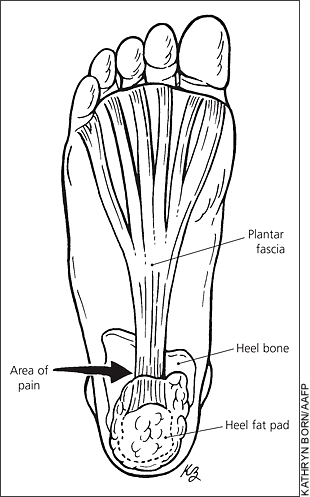
Am Fam Physician. 2005;72(11):2247-2248
See related article on plantar fasciitis.
What is plantar fasciitis?
The plantar fascia (say: PLAN-tar FASH-ee-ah) is a band of tough fiber on the bottom of your foot (see drawing). It runs from your toes to your heel and forms the arch of your foot. When this tissue becomes hot, red, swollen, and sore, it is called plantar fasciitis (say: fash-ee-EYE-tis). Plantar fasciitis makes your heel hurt when you walk. The pain is usually worse when you get out of bed in the morning or when you walk after sitting for a long time. Walking barefoot, walking on tiptoe, or walking up stairs may make the pain worse.
Who gets plantar fasciitis?
About 10 percent of people have plantar fasciitis. People who spend most of the day on their feet, who are overweight, and who cannot move their feet and ankles very well are more likely to get plantar fasciitis. If you become more active than usual too fast, you may get plantar fasciitis.
How do I know if I have plantar fasciitis?
Your doctor can tell you if you have plantar fasciitis by looking at your foot and asking you a few questions. You probably will not need special tests. Most people with plantar fasciitis have pain on the bottom and inside of the heel.

What should I do if I have plantar fasciitis?
You will feel better if you rest and take medicines such as ibuprofen (brand: Motrin) or naproxen (brand: Naprosyn). It also will help if you wear comfortable shoes or shoe inserts and stretch your foot. For more severe pain, you may need to wear a cast or splint on your foot. A few people may need surgery.
The pain should get better soon, but it may take weeks or months to go away completely. In some people, the pain lasts for a few years.
What can I do to keep from getting plantar fasciitis?
To prevent plantar fasciitis, you should wear good shoes and stay at a healthy weight. If you want to become more active, start slowly.